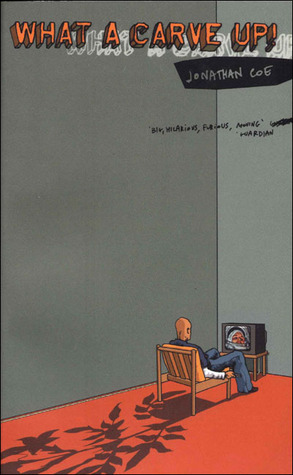Our book choice for November 2007 is What a Carve Up! by Jonathan Coe. A billiant noir farce, a dystopian vision of Britain, a family history and the story of an obsession.
What a Carve Up! is a satirical novel by Jonathan Coe, published in 1994. The novel is a critique of British politics under the Conservative government of Margaret Thatcher (and, briefly, John Major) and of the ways in which national policy was seen to be dictated by the concerns of narrow, but powerful, interest groups with influence in banking, the media, agriculture, healthcare, the arms trade and the arts. Coe creates the fictitious Winshaw family to embody these different interests under one name and, ultimately, one roof.
The novel is narrated by Michael Owen, a novelist who is commissioned to write a biography of the Winshaw family. Michael is initially reluctant to take on the project, but he is eventually persuaded by the large sum of money that is offered to him. As he begins his research, Michael uncovers a dark and twisted history of the Winshaws, a family whose wealth and power has been built on exploitation, corruption, and murder.
The novel is divided into three parts. The first part, “The Winshaw Legacy,” tells the story of the Winshaw family from the 17th century to the present day. The second part, “The Carve Up,” follows Michael as he investigates the Winshaws’ past. The third part, “The Legacy,” tells the story of Michael’s own life, and the way in which it has been shaped by the Winshaws.
What a Carve Up! is a complex and multi-layered novel that is full of wit, satire, and black humor. The novel is also a powerful indictment of the British establishment and the way in which it has used its power to enrich itself at the expense of the common people.
One of the most striking aspects of the novel is Coe’s use of intertextuality. The novel is littered with references to other works of literature, film, and music. These references serve to enrich the novel’s meaning and to create a sense of irony. For example, the novel’s title is taken from a line in the film The Wicker Man, a film that is itself a critique of religious hypocrisy.
Another striking aspect of the novel is its structure. The novel is told in a non-linear fashion, with the events of the past being constantly interwoven with the events of the present. This structure creates a sense of suspense and mystery, and it also allows Coe to explore the theme of legacy.
Discussion Questions
- What is the significance of the title, What a Carve Up!?
- How does the novel use satire to explore the themes of greed, corruption, and power?
- What is the role of the narrator, Michael Owen, in the novel?
- How does the novel’s structure (e.g., the use of different narrative modes) contribute to its meaning?
- What are the parallels between the Winshaw family and the British establishment in the 1980s?
- What does the novel say about the relationship between the media and power?
- How does the novel explore the nature of evil?
- What is the significance of the character of Shirley Eaton?
- What is the role of humor in the novel?
- What is the novel’s message about the human condition?
- How does the novel reflect the political and social climate of the 1980s?
- How does the novel compare to other works of satire, such as Animal Farm or Nineteen Eighty-Four?
- What is the novel’s lasting significance?
- What are your thoughts on the ending of the novel?
- To whom would you recommend the novel? Why?

